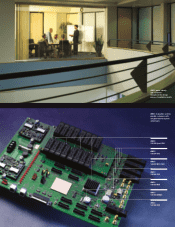3Ware 2000 Annual Report Download - page 21
Download and view the complete annual report
Please find page 21 of the 2000 3Ware annual report below. You can navigate through the pages in the report by either clicking on the pages listed below, or by using the keyword search tool below to find specific information within the annual report.
19 2000
AMCC
MANAGEMENT’S DISCUSSION AND ANALYSIS OF FINANCIAL CONDITION AND RESULTS OF OPERATIONS
BACKLOG. Our backlog for products requested to be shipped and nonrecurring engineering services to be completed
in the next six months was $38.2 million on March 31, 1999, compared to $30.1 million on March 31, 1998. Included in
backlog at March 31, 1999 was the $9.3 million balance of an order received from Raytheon Systems Co. related to an
end-of-life buy for integrated circuits used in its high-speed radar systems.
LIQUIDITY AND CAPITAL RESOURCES
Our principal source of liquidity as of March 31, 2000 consisted of $954.6 million in cash, cash equivalents and short-
term investments. Working capital as of March 31, 2000 was $977.6 million, compared to $103.6 million as of
March 31, 1999. This increase in working capital was primarily due to the proceeds of our public stock offering of approx-
imately $815 million and approximately $65 million of cash provided by our operating activities, offset by the purchase
of property, equipment and other assets.
For the years ended March 31, 2000, 1999 and 1998, net cash provided by operating activities was $65.3 million,
$22.0 million and $16.9 million, respectively. Net cash provided by operating activities in fiscal 2000 and 1999
primarily reflected net income before depreciation and amortization expense and the tax benefit of disqualified disposi-
tions, offset by increases in accounts receivable, inventories and other assets.
Capital expenditures totaled $22.8 million, $16.5 million and $11.6 for the years ended March 31, 2000, 1999 and
1998, respectively, of which $0, $6.7 million and $3.6 million for the years ended March 31, 2000, 1999 and 1998,
respectively, were financed using debt or capital leases. In fiscal year 2001, we expect to incur approximately $36 mil-
lion in capital expenditures for manufacturing and test equipment, computer hardware and software and leasehold
improvements for our new engineering facility.
We are exploring alternatives for the expansion of our manufacturing capacity, which would likely occur after fiscal year
2001, including further expansion of our current wafer fabrication facility, building a new wafer fabrication facility, pur-
chasing a wafer fabrication facility and/or entering into strategic relationships to obtain additional capacity. Any of these
alternatives could require a significant investment by us and there can be no assurance that any of the alternatives for
expansion of our manufacturing capacity will be available on a timely basis or at all.
In January 2000, we completed the public offering of approximately 12 million shares of common stock, raising net
proceeds of approximately $815 million. We intend to use the proceeds of the offering for working capital and general
corporate purposes. In addition, we may use a portion of the net proceeds to acquire businesses or technologies.
We believe that our available cash, cash equivalents and short-term investments and cash generated from operations, will
be sufficient to meet our capital requirements for the next 12 months, although we could elect or could be required to
raise additional capital during such period. There can be no assurance that such additional debt or equity
financing will be available on commercially reasonable terms or at all.
MARKET RISK
At March 31, 2000, our investment portfolio includes fixed-income securities of $784.4 million. These securities
are subject to interest rate risk and will decline in value if interest rates increase. Because the maturity dates of our
investment portfolio are relatively short, an immediate 100 basis point increase in interest rates would have no material
impact on our financial condition or results of operations.
We generally conduct business, including sales to foreign customers, in U.S. dollars and, as a result, we have limited
foreign currency exchange rate risk. The effect of an immediate 10 percent change in foreign exchange rates would not
have a material impact on our financial condition or results of operations.
























